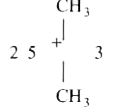The soaps contain salts of higher fatty acids like
Stearic acid
oxalic acid
Palmitic acid
Oleic acid
The correct Answer is:A, C, D
To answer the question "The soaps contain salts of higher fatty acids like," we need to identify which of the given options are higher fatty acids. Let's analyze each option step by step.
Step 1: Understanding Fatty Acids
Fatty acids are carboxylic acids with long aliphatic chains. They can be either saturated (no double bonds) or unsaturated (one or more double bonds). Higher fatty acids typically have long carbon chains, usually containing more than 12 carbon atoms.
Step 2: Analyzing the Options
We have four options to consider:
1. Stearic Acid (C18H36O2):
- Structure: CH3(CH2)16COOH
- This is a saturated fatty acid with a long carbon chain (18 carbons).
- Conclusion: Stearic acid is a higher fatty acid.
2. Oxalic Acid (C2H2O4):
- Structure: HOOC-COOH
- This is a dicarboxylic acid with only 2 carbon atoms and no long aliphatic chain.
- Conclusion: Oxalic acid is not a fatty acid.
3. Palmitic Acid (C16H32O2):
- Structure: CH3(CH2)14COOH
- This is a saturated fatty acid with a long carbon chain (16 carbons).
- Conclusion: Palmitic acid is a higher fatty acid.
4. Oleic Acid (C18H34O2):
- Structure: CH3(CH2)7CH=CH(CH2)7COOH
- This is an unsaturated fatty acid with a long carbon chain (18 carbons).
- Conclusion: Oleic acid is a higher fatty acid.
Step 3: Final Conclusion
From the analysis:
- Stearic acid, palmitic acid, and oleic acid are higher fatty acids.
- Oxalic acid does not qualify as a higher fatty acid.
Answer
The soaps contain salts of higher fatty acids like stearic acid, palmitic acid, and oleic acid.
---
Fatty acids are carboxylic acids with long aliphatic chains. They can be either saturated (no double bonds) or unsaturated (one or more double bonds). Higher fatty acids typically have long carbon chains, usually containing more than 12 carbon atoms.
We have four options to consider:
- Structure: CH3(CH2)16COOH
- This is a saturated fatty acid with a long carbon chain (18 carbons).
- Conclusion: Stearic acid is a higher fatty acid.
- Structure: HOOC-COOH
- This is a dicarboxylic acid with only 2 carbon atoms and no long aliphatic chain.
- Conclusion: Oxalic acid is not a fatty acid.
- Structure: CH3(CH2)14COOH
- This is a saturated fatty acid with a long carbon chain (16 carbons).
- Conclusion: Palmitic acid is a higher fatty acid.
- Structure: CH3(CH2)7CH=CH(CH2)7COOH
- This is an unsaturated fatty acid with a long carbon chain (18 carbons).
- Conclusion: Oleic acid is a higher fatty acid.
From the analysis:
- Stearic acid, palmitic acid, and oleic acid are higher fatty acids.
- Oxalic acid does not qualify as a higher fatty acid.
The soaps contain salts of higher fatty acids like stearic acid, palmitic acid, and oleic acid.
Topper's Solved these Questions
- HYDROGENBOOK - AAKASH INSTITUTE ENGLISHCHAPTER - HYDROGENEXERCISE - Assignment (Section-D)
5 Videos
- HYDROGENBOOK - AAKASH INSTITUTE ENGLISHCHAPTER - HYDROGENEXERCISE - Assignment (Section-E)
7 Videos
- HYDROGENBOOK - AAKASH INSTITUTE ENGLISHCHAPTER - HYDROGENEXERCISE - Assignment (Section-B)
19 Videos
- HYDROCARBONSBOOK - AAKASH INSTITUTE ENGLISHCHAPTER - HYDROCARBONSEXERCISE - Assignment(Section - C) (Previous Years Questions)
60 Videos
- M0ck test 26BOOK - AAKASH INSTITUTE ENGLISHCHAPTER - M0ck test 26EXERCISE - EXAMPLE
43 Videos
Similar Questions
Knowledge Check
Passage-3
Soaps are the detergents used since long. Soaps used for cleansing purpose are sodium or potassium salts of long chain fatty acids such as stearic acid, palmitic acid. These cannot be used with hard water. Synthetic detergents are cleansing agents which have all the properties of soap but which actually do not contain any soap. These can be used both in soft water and hard water as they give foam even in hard water.
Which of the following is called invert soap?ASodium stearateBCetyl trimethyl ammonium bromideCSodium lauryl sulphateDTetraethyl ammonium chloridePassage-3
Soaps are the detergents used since long. Soaps used for cleansing purpose are sodium or potassium salts of long chain fatty acids such as stearic acid, palmitic acid. These cannot be used with hard water. Synthetic detergents are cleansing agents which have all the properties of soap but which actually do not contain any soap. These can be used both in soft water and hard water as they give foam even in hard water.
Which is not true for a detergent molecule ?AIt has a non polar organic part and a polar groupBIt has a surface active reagentCIt is a sodium salt of a fatty acidDIt is not easily biodegradedPassage-3
Soaps are the detergents used since long. Soaps used for cleansing purpose are sodium or potassium salts of long chain fatty acids such as stearic acid, palmitic acid. These cannot be used with hard water. Synthetic detergents are cleansing agents which have all the properties of soap but which actually do not contain any soap. These can be used both in soft water and hard water as they give foam even in hard water.
Which one of the following is not a surfactant?A BCH3(CH2)4CH2NH2CCH3−(CH2)16CH2OSO−2Na+DOHC−(CH2)4CH2COO−Na+
BCH3(CH2)4CH2NH2CCH3−(CH2)16CH2OSO−2Na+DOHC−(CH2)4CH2COO−Na+
Waxes are esters of higher fatty acids with long chain of
View SolutionIn contact with water, fatty acids produce
View SolutionLipase acts on fats to change them into fatty acids and ________
View SolutionUnsaturated fatty acids
View SolutionWhich one of the following fats contains unsaturated fatty acids?
View Solution
